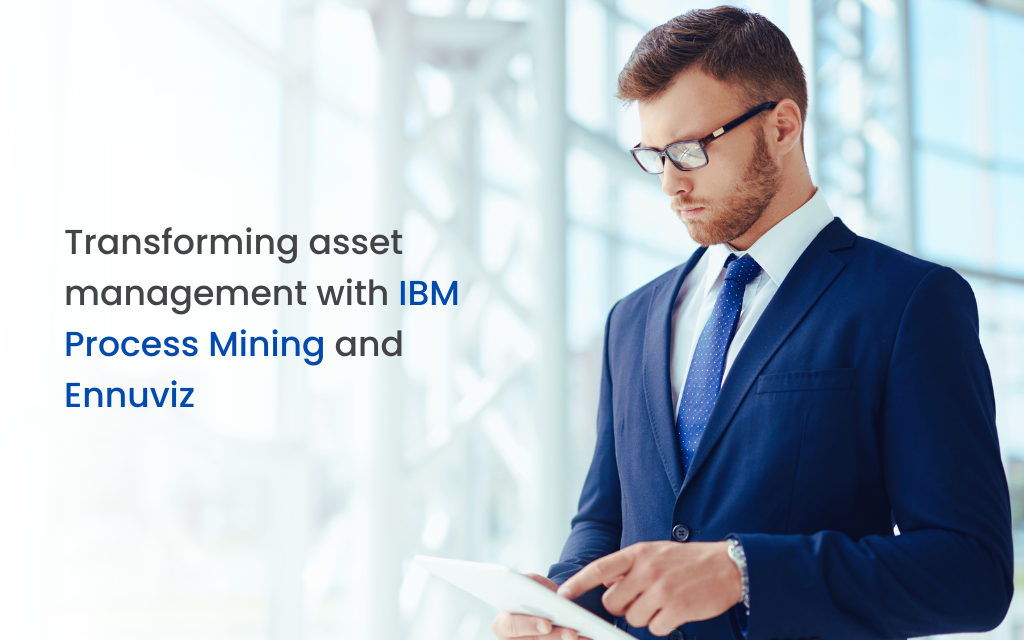
Transforming asset management with IBM Process Mining and Ennuviz
Asset management is the effective governance of existing wealth and creating a portfolio of investment over the years to increase through investment, trading, and acquisition of wealth. Sustaining losses is impractical without physical assets to profit off of. An investment manager usually leads asset management for a wealthy individual or company. The goal of asset management is set through a set of financial requirements from the clients. Infusing technology with wealth management creates an array of advanced asset management advisory operations.

Nancy Elvira
Content Writer
Table of content
Asset management doesn't stop with finance planning but extends to wealth protection, family wealth governance and tax planning. Asset management effectively builds, upgrades and discards wealth while protecting the net worth of an individual, a family or a firm. Though wealth management has been around for quite a long time, it has evolved a lot over the past decade, inoculating the tech revolution.
Asset management begins with a financial planner or asset manager who organizes the investment portfolio, abiding by the client's requirements. The asset manager tries to understand the client's needs, risk tolerance, time frame of investment, existing asset value and expected asset growth rate. These conditions are mentioned in the investment portfolio. Within these constraints, the asset manager creates a blend of assets lined up for the investment portfolio, footing the asset allocation. Assets are spread across investment classes to develop a balanced weightage for each investment. Each investment is scrutinized to fractions, and an appropriate investment class is selected.
Now, the information so far is collated as a portfolio filing the expected returns each asset is expected to make. The current, past, and anticipated future market conditions are also marked against the asset collation. The asset manager consistently monitors these recorded data. Notably, the investment strategy here isn't static and is frequently altered.
When process mining is introduced to this process, it scans the entire process to pinpoint inefficiencies, balance risks, increase asset performance and reduce cost. Though assets generate considerable revenue, they also increase expenditure through maintenance expenditure, unplanned downtime, equipment failure, safety incidents and labour shortages. The expenditures below reduce risks and hence need timely attention, but overspending on these aspects soars expenditure.
The end-to-end asset lifecycle can be mapped and monitored through IBM Process Mining Asset.
Diversified data classes are aggregated altogether using IBM process mining. These data records include all details an asset register entails, such as acquisition details, transactions, portfolio records, asset location, depreciation rate, maintenance costs, purchase details, financial market data, risk assessments, compliance regulations, etc. These details can exist as standalone information in each of their sources or a portfolio/wealth management system. The databases for this information can be varied, unstructured, or erred. Data is extracted using IBM process mining from all available sources and is harmonized into a comparable view schema. Identical entities across data sources are linked this way.
Now that we have the data, the process flow is mapped, and the management workflow is assessed. After the data is prepared, IBM Process Mining creates comprehensive visual maps of the asset management process. This visualization aims to help users better comprehend the reasoning behind the decisions and actions taken to achieve certain goals, including acquiring or selling assets or reallocating funds within an investment portfolio. Breaking down the asset management process into steps reveals every detail. To illustrate, when an asset is added to your portfolio, many steps are involved, including research, risk assessment, consulting with the customer, checking for compliance, and executing the transaction. Process mining improves transparency by revealing the allocation of time and resources at each stage.
Strict regulatory limits are enforced on asset management firms. Incorporating these regulations into routine operations becomes much easier with process mining, which reduces the likelihood of non-compliance. IBM Process Mining provides real-time alerts by continuously monitoring process and transaction trends. This enables rapid corrective action.
Ennuviz incorporates IBM's advanced process mining technologies to improve asset management operational efficiency, compliance, and customer service.
For a complete picture of the asset management process, Ennuviz leverages IBM Process Mining solutions. You can see every stage of the process, from enrolling clients to managing their portfolios and ensuring compliance. Everything from client-manager interactions to decision points and transaction flows falls under this category. The client can learn about these best practices and areas that require standardization by seeing how various teams or people within the same company approach asset management.
Ennuviz examines performance across the whole asset management process with the help of IBM Process Mining. This allows them to pinpoint inefficiencies in risk assessment procedures, delayed reactions to market changes, or delays in the asset approval process, among other bottlenecks. Additionally, we quantify the impact of these bottlenecks by evaluating how they impact overall performance.
Asset management doesn't stop with finance planning but extends to wealth protection, family wealth governance and tax planning. Asset management effectively builds, upgrades and discards wealth while protecting the net worth of an individual, a family or a firm. Though wealth management has been around for quite a long time, it has evolved a lot over the past decade, inoculating the tech revolution.
Asset Management Process
Asset management begins with a financial planner or asset manager who organizes the investment portfolio, abiding by the client's requirements. The asset manager tries to understand the client's needs, risk tolerance, time frame of investment, existing asset value and expected asset growth rate. These conditions are mentioned in the investment portfolio. Within these constraints, the asset manager creates a blend of assets lined up for the investment portfolio, footing the asset allocation. Assets are spread across investment classes to develop a balanced weightage for each investment. Each investment is scrutinized to fractions, and an appropriate investment class is selected.
Now, the information so far is collated as a portfolio filing the expected returns each asset is expected to make. The current, past, and anticipated future market conditions are also marked against the asset collation. The asset manager consistently monitors these recorded data. Notably, the investment strategy here isn't static and is frequently altered.
IBM Process Mining in Asset Management
When process mining is introduced to this process, it scans the entire process to pinpoint inefficiencies, balance risks, increase asset performance and reduce cost. Though assets generate considerable revenue, they also increase expenditure through maintenance expenditure, unplanned downtime, equipment failure, safety incidents and labour shortages. The expenditures below reduce risks and hence need timely attention, but overspending on these aspects soars expenditure.
The end-to-end asset lifecycle can be mapped and monitored through IBM Process Mining Asset.
1. Data Aggregation
Diversified data classes are aggregated altogether using IBM process mining. These data records include all details an asset register entails, such as acquisition details, transactions, portfolio records, asset location, depreciation rate, maintenance costs, purchase details, financial market data, risk assessments, compliance regulations, etc. These details can exist as standalone information in each of their sources or a portfolio/wealth management system. The databases for this information can be varied, unstructured, or erred. Data is extracted using IBM process mining from all available sources and is harmonized into a comparable view schema. Identical entities across data sources are linked this way.
2. Workflow Visualization
Now that we have the data, the process flow is mapped, and the management workflow is assessed. After the data is prepared, IBM Process Mining creates comprehensive visual maps of the asset management process. This visualization aims to help users better comprehend the reasoning behind the decisions and actions taken to achieve certain goals, including acquiring or selling assets or reallocating funds within an investment portfolio. Breaking down the asset management process into steps reveals every detail. To illustrate, when an asset is added to your portfolio, many steps are involved, including research, risk assessment, consulting with the customer, checking for compliance, and executing the transaction. Process mining improves transparency by revealing the allocation of time and resources at each stage.
3. Regulatory Compliance Monitoring
Strict regulatory limits are enforced on asset management firms. Incorporating these regulations into routine operations becomes much easier with process mining, which reduces the likelihood of non-compliance. IBM Process Mining provides real-time alerts by continuously monitoring process and transaction trends. This enables rapid corrective action.
Ennuviz's Potential in Asset Management Processes
Ennuviz incorporates IBM's advanced process mining technologies to improve asset management operational efficiency, compliance, and customer service.
For a complete picture of the asset management process, Ennuviz leverages IBM Process Mining solutions. You can see every stage of the process, from enrolling clients to managing their portfolios and ensuring compliance. Everything from client-manager interactions to decision points and transaction flows falls under this category. The client can learn about these best practices and areas that require standardization by seeing how various teams or people within the same company approach asset management.
Ennuviz examines performance across the whole asset management process with the help of IBM Process Mining. This allows them to pinpoint inefficiencies in risk assessment procedures, delayed reactions to market changes, or delays in the asset approval process, among other bottlenecks. Additionally, we quantify the impact of these bottlenecks by evaluating how they impact overall performance.
Recommended Blogs


 Grace Catharine
Grace CatharineThe Journey of Process Mining: Past, Present, and Future

 Nancy Elvira
Nancy ElviraWhat is the AI Revolution Today?

 Grace Catharine
Grace CatharineThe Journey of Process Mining: Past, Present, and Future

 Nancy Elvira
Nancy ElviraWhat is the AI Revolution Today?

 Grace Catharine
Grace CatharineThe Journey of Process Mining: Past, Present, and Future
Let's get started today
Because we put you first. Our customer-obsessed working model honors client's needs.
Schedule DemoJoin our Newsletter. Stay Connected
Empowering Leaders to Transform the Future
Fuel your ambition with expert insights and strategies to drive your Business Transformation. For growth-minded leaders, this is where innovation meets opportunity. Stay bold and lead the curve!

 Scott Defries
Scott Defries
 Ennuviz
Ennuviz
 Nancy Elvira
Nancy Elvira